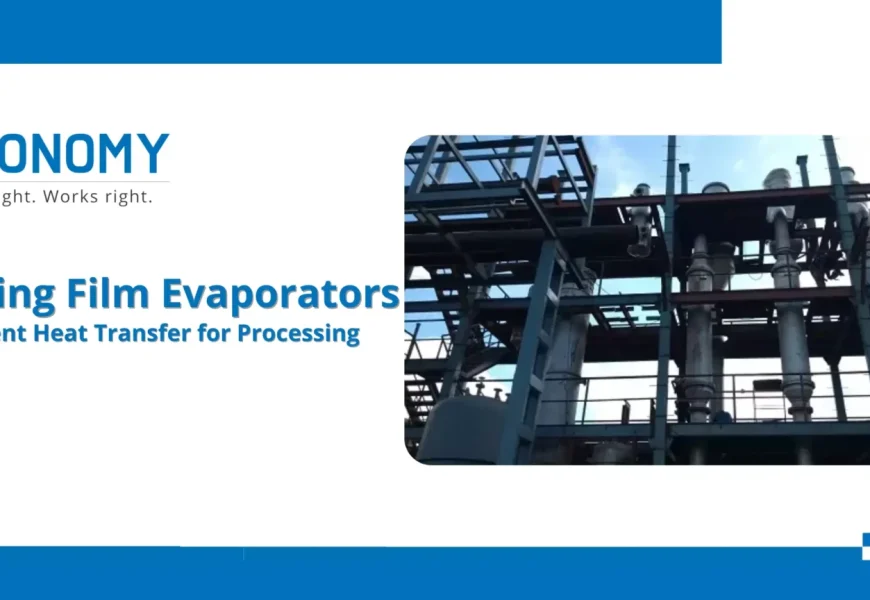Definition Of Falling Film Evaporators
A falling film evaporator is a type of heat exchanger specifically designed to concentrate solutions, particularly those that are heat-sensitive or prone to fouling. It functions by creating a thin film of liquid that flows down the inside of a vertical tube or series of tubes. This design maximizes the surface area exposed to heating media, which typically surrounds the external walls of the tubes.
By allowing the liquid to flow as a thin film, the evaporator achieves rapid heat transfer while operating at lower temperatures compared to other types of evaporators. This minimizes thermal degradation of the solution being concentrated, which is a critical advantage when processing delicate or sensitive substances. The thin film also facilitates a uniform evaporation process, reducing the potential for hot spots and thereby mitigating the risk of product burn-on or fouling.
Falling film evaporators are renowned for their efficiency, as they can achieve high evaporation rates with low energy consumption, making them ideal for industries where energy efficiency and product quality are paramount. The design inherently supports flexible operation, accommodating varying flow rates while maintaining consistent performance. These attributes make falling film evaporators a preferred choice in industries such as food and beverage, pharmaceuticals, and chemicals, where maintaining product integrity and achieving cost-effective processing are key objectives.
How Falling Film Evaporators Work
How Falling Film Evaporators Work – facilitating efficient heat transfer through the thin distribution of liquid over a heat exchange surface. The process begins as the liquid feed enters the evaporator and is distributed uniformly over the inner surface of vertically oriented tubes. This liquid forms a thin film as it gravitates downward under the influence of gravity. The falling liquid film can be further assisted by applying mechanical means, such as a distributor or a sprayer, to ensure an even coating across the surface, optimizing the evaporative action.
Heat is introduced externally, typically using steam or another heating medium surrounding the tubes. As the heat is transferred through the tube walls to the liquid, the solvent – which might be water or another volatile component – vaporizes due to increased energy. This phase change from liquid to vapor reduces the temperature required for boiling, hence increasing efficiency. With the liquid film being thin, it encourages rapid heat transfer that minimizes temperature gradients and prevents overheating, which can degrade sensitive materials.
Advantages Of Falling Film Evaporators
Falling film evaporators are known for their efficiency and versatility, offering several advantages in the processing industries. One of the key benefits is their ability to handle heat-sensitive materials. Because the liquid film flows down the heated surface as a thin layer, it has minimal contact time with high temperatures, reducing the risk of thermal degradation. This makes falling film evaporators ideal for processing products such as pharmaceuticals, food items, and other sensitive chemicals.
Another advantage is their high heat transfer coefficients, which are achieved due to the efficient distribution of the liquid film across the surface, promoting rapid heat exchange. This characteristic allows falling film evaporators to achieve higher evaporation rates with lower energy consumption compared to other types of evaporators. Additionally, the ability to operate at lower temperature differentials enhances energy efficiency and reduces operating costs.
Applications Of Falling Film Evaporators
Falling film evaporators are crucial in various industries due to their efficient and effective heat transfer capabilities, making them a preferred choice for multiple applications. One of the primary applications is in the food and beverage industry, where they are used for the concentration of products like fruit juices, dairy goods, and other liquid foods. The gentle handling of the product in falling film evaporators helps preserve essential flavors and nutrients, which is vital in maintaining the quality of consumables.
In the pharmaceutical industry, these evaporators are employed for concentrating herbal extracts, producing vaccines, and processing antibiotics. The capability to operate at low temperatures without compromising efficiency is beneficial in preserving the active components that might be sensitive to heat. Furthermore, the chemical industry leverages these evaporators for concentrating chemical solutions, recovering solvents, and processing heat-sensitive chemicals, offering precise control over the evaporation process.
Design Of Falling Film Evaporators
The design of falling film evaporators is fundamental to their efficiency and effectiveness in processing applications. These evaporators typically consist of a vertical shell and tube heat exchanger, where the liquid to be evaporated is distributed as a thin film along the inner surface of the tubes. This design facilitates a large surface area for heat transfer, enabling efficient evaporation at lower temperatures compared to other types of evaporators.
Key elements in the design process include the selection of materials that withstand corrosion and high temperatures, and the configuration of the distribution system at the top of the tubes to ensure an even liquid distribution, preventing dry patches that could lead to fouling or scaling. The tube dimensions and the length-to-diameter ratio are carefully calculated to optimize heat transfer and minimize energy consumption.
Operation Of Falling Film Evaporators
Falling film evaporators operate by efficiently distributing a liquid feed over the surface of heat transfer tubes, creating a thin film that promotes rapid evaporation. In these systems, the liquid is introduced at the top of a vertical bundle of tubes. Gravity then aids in drawing the liquid downward as a film that coats the outside or inside of the tubes, depending on the specific design.
The creation of this thin film enhances the rate of heat exchange between the heating medium and the liquid, primarily because the reduced thickness minimizes thermal resistance while maximizing the exposed surface area. Heat, typically supplied by steam or another heating fluid, flows through one side of the tube wall. As it transfers through to the liquid film, the heat causes the volatile components of the liquid film to evaporate efficiently.










